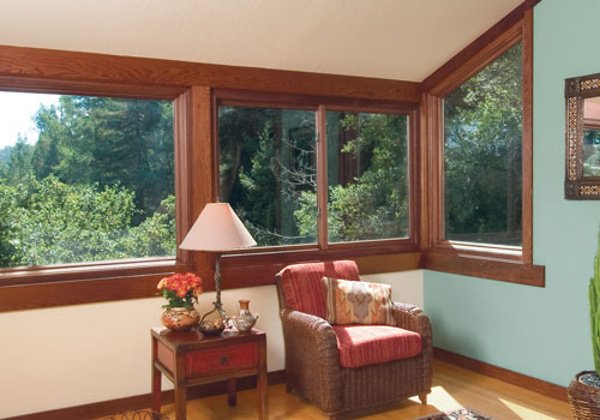


Do you have gliding windows that open by sliding to the side? This style of window is wonderful for porches, walkways and patios in Michigan where you want plenty of ventilation but don’t want to deal with the intrusion of windows swinging inward or outward. If your gliding windows are becoming loose in their frames, are inefficient, or are simply beginning to look a bit worse for wear, it may be time to replace them. Here are a few things to consider as you choose replacement gliding windows.
What material are the sashes and frames made from?
Like most styles of windows, gliding windows come encased in a variety of materials. While wood offers a classic look, a better choice when you’re buying a gliding window is Fibrex®. This patented material from Renewal by Andersen has the look of wood and is made with real wood fibers. However, it’s not prone to splintering or rotting like wood, so you don’t have to worry about your gliding windows losing their ability to slide in the sash as the sash or frame breaks down.
Fibrex® is also stronger than wood, which means that frames made from it can have a narrower profile. So, a greater portion of your window is actual glass, which is a great advantage on a patio, deck, or porch where you really want to be able to look through your windows and enjoy the great outdoors.
Unlike vinyl, which can contract and expand as the temperature changes and lead to bowing that would make it impossible to slide the windows open and shut, Fibrex® resists temperature-dependent expansion and contraction.
How easy are the windows to clean?
You need to make sure it’s easy to access and clean the exterior of your windows and also the window tracks. Look for sliding windows, like those from Renewal By Andersen, which lift out of the tracks so that you can clean the exterior surfaces from inside your home. You also want to ensure the tracks of the window are made from smooth material, so they’re easy to wipe down. Avoid windows with felt or any other sort of rough material in the tracks, as this tends to accumulate dirt and is very hard to wipe clean. Windows in which both side-by-side panels slide are easier to clean than those where only one panel slides.
How energy-efficient is the glass?
Since gliding windows have such a large glass surface, it’s vitally important to ensure the glass you choose for them is energy-efficient — especially in the Midwest where the winters are cold and the summers are hot. A low-e glass like Renewal by Andersen’s High-Performance™ Low-E4® glass will keep the heat of the sun from raising your interior temperature in the summer. A tint coating helps reduce glare while still letting in enough light to keep your room feeling bright and summery.
Choosing double-pane glass over single-pane glass will provide some extra insulating benefits in the winter. The layer of gas trapped between the glass acts as a buffer, slowing the rate at which your home’s heat is transferred through the glass. For even greater insulating benefits, you may want to consider double-pane windows with Argon gas between the panes. Argon is an even better insulator than air and results in windows with peak efficiency.
If you choose windows with energy-efficient glass, frames and sashes that are durable, and a structure that is easy to clean, you’ll be enjoying your gliding windows for years to come. When you’re ready to replace the gliding windows in your home, get in touch with Renewal by Andersen to learn more about our options.